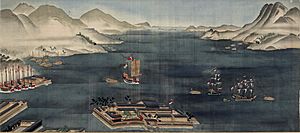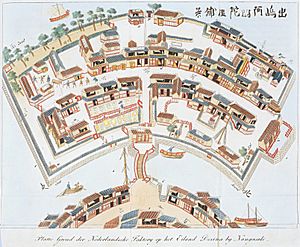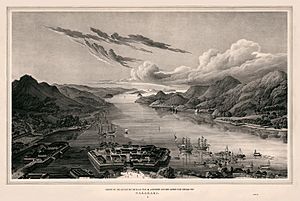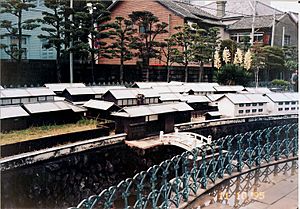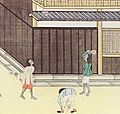Dejima facts for kids
Dejima (pronounced Deh-jee-mah) was a small, fan-shaped island built by people in the bay of Nagasaki. It was created in 1634 by digging a canal through a small piece of land.
For a long time, from 1641 to 1853, Dejima was the only place where Japan traded and had contact with the outside world. This was part of Japan's "sakoku" policy, which meant the country was mostly closed off to foreigners.
Dejima was first built for Portuguese traders. Later, it became a trading post for Chinese and Dutch merchants. The island was about 120 meters long and 75 meters wide. Today, Dejima is no longer an island; it's part of the city of Nagasaki. It is now a special Japanese national historic site called the "Dejima Dutch Trading Post."
Contents
History of Dejima
Early Trade with Portugal
The first Portuguese traders arrived in Japan in 1543. A few years later, a missionary named Francis Xavier came to Kyushu. At first, Portuguese traders were based in a place called Hirado.
They then looked for a better port. In 1570, a powerful Japanese leader called a daimyo named Ōmura Sumitada became a Catholic. He made a deal with the Portuguese to improve Nagasaki for trade. Soon, Nagasaki became an open port. The Portuguese were the only ones trading silk with China through Macau.
Building the Artificial Island
In 1634, the Japanese military ruler, or Shogun, Iemitsu, ordered Dejima to be built. His main reason was to keep the Portuguese merchants living in Nagasaki in one specific area.
After a big uprising called the Shimabara Rebellion, which involved many Christians, the Japanese government banned almost all Westerners. Only the Dutch employees of the Dutch East India Company (called the VOC) were allowed to stay. Without the yearly Portuguese ships, Nagasaki's economy suffered a lot.
Dutch Traders Move to Dejima
The Dutch had a trading post on Hirado since 1609. But in 1641, Japanese officials made the Dutch move from Hirado to Dejima. From then on, only Chinese and Dutch ships were allowed to come to Japan.
Every ship that arrived at Dejima was carefully checked. Their sails were removed until they were ready to leave. Religious books and weapons were taken away. No religious services were allowed on the island.
How Dejima Was Organized
Dejima was a small island, about 120 meters by 75 meters. It was owned by 25 local Japanese families who rented it to the Dutch each year. A small bridge with guards connected the island to the mainland. There were houses for about twenty Dutchmen and storage buildings for goods.
Japanese officials, gatekeepers, and night watchmen kept a close eye on the Dutch. There was also a main supervisor, called an otona, who had about fifty people working for him. Many traders sold food, drinks, and other things to the people on Dejima. There were also about 150 tsūji (translators). The Dutch East India Company (VOC) had to pay all these people. Like the city of Nagasaki, Dejima was directly controlled by the Japanese government in Edo.
Costs and Profits
It was very expensive for the Dutch to run their trading post on Dejima. However, their trade with Japan was very profitable for the VOC, especially at first. They sometimes made profits of 50% or more!
Trade became less busy in the 1700s because only two ships per year were allowed to dock at Dejima. The VOC ran out of money in 1795 and went bankrupt. After that, the Dutch government took over the trade with Japan.
Life on Dejima became especially hard when the Netherlands was controlled by the French ruler Napoleon. All contact with their home country was cut off. For a while, Dejima was the only place in the world where the Dutch flag was still flown because it wasn't under French rule.
The most important Dutch official in Dejima was called the Opperhoofd by the Dutch. The Japanese also called him Kapitan, which came from a Portuguese word meaning "captain."
Related pages
Images for kids
-
A 2017 model of Dejima in the Museum Volkenkunde in Leiden.
-
A monument built in Dejima by Siebold to honor Kaempfer and Thunberg.
See also
 In Spanish: Dejima para niños
In Spanish: Dejima para niños


